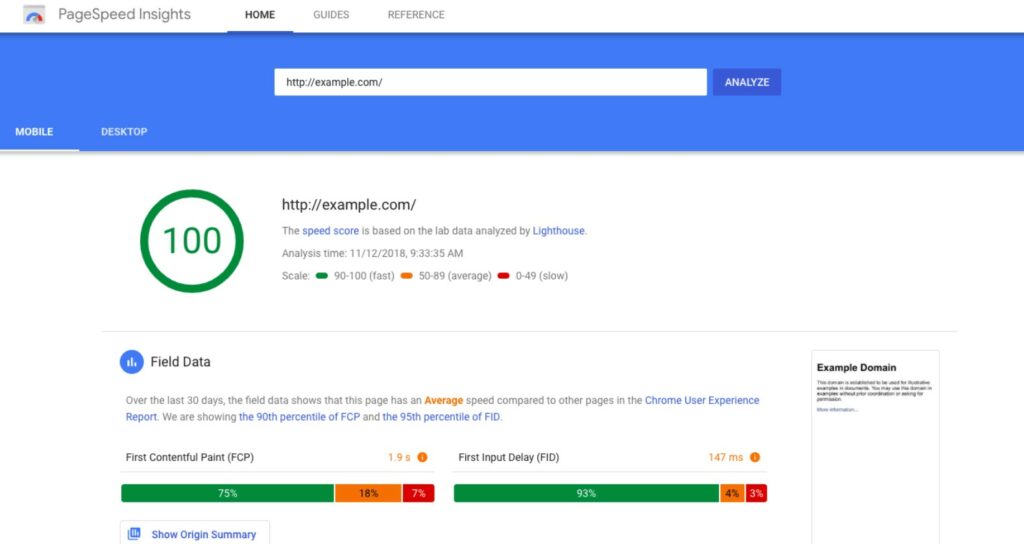Web Hosting and Domain
Take into account the ranking factors even at the stage of choosing a domain for your site. Some characteristics can attract the audience, while others might look suspicious. Therefore, you should clearly understand what factors influence the domain quality before purchasing one.
1. Domain Registration Time Frame
Domains for low-quality or, possibly, some illegal sites are rarely renewed for more than a year. However, remember that there are domain zones where the domain renewal period is limited to a maximum of one year.

2. Domain Age
Domain age influences website ranking on Google though it is not the most important factor.
Matt Cutts, a former employee at Google’s search quality team, states that there is almost no difference between a six-month and a year-old domain.
John Mueller, Webmaster Trends Analyst at Google, was even more accurate, saying “no” to both as ranking factors: the age of the domain and the registration time frame. It’s worth considering these factors, but not as the main.
3. Domain Name
The more the domain name matches the key query, the better. The same applies to the subdomain. Still, they are not a determining factor, according to John Mueller.
Moreover, since a lot of EMDs (exact-match domains) were detected using spamming methods, Google began to actively use an EMD algorithm that closed the ranking doors for low-quality EMDs.
4. Tld (Top-Level Domains) With Country Code
Such domains (for instance, .au, .de, .fr) can help your site rank in a certain region, but at the same time they will limit the global visibility of the site. So, try to understand your target audience’s geolocation and choose the best TDL for it.
5. Domain History
A site with a frequently changing hosting or “downs” in operation may cause Google to delete the site history and not consider links to the domain. In certain cases, new site owners may be subject to sanctions.
6. Hiding Whois Data
Hiding your data can protect you from malicious users, but it can also arouse suspicion. Google’s Matt Cutts said: “… When I checked the owners of the sites, everyone had protected private data. This is a bit unusual … Of course, the private mode does not automatically mean something bad, but when several factors are brought together the impression is made that the owner is unreliable compared to a normal webmaster.”
Site-Level Optimization
Technical factors primarily affect the correct site operation, its user-friendliness, and indexing speed. It is worth starting internal optimization with work on technical errors, as this will create an effective base for further improving Google rank.
Loading Speed
Site speed has long been a ranking factor, and in 2018 it became especially important for mobile search. Since a lot of requests today are performed on mobile devices, and users tend to leave a website that takes more than 3 seconds to load, a faster website is a huge advantage.

Moreover, Google provides more ranking features for faster sites. Thus, it is very important to take the necessary steps to increase the speed of your site (which may include the use of CDN, compression, redirects reduction, images and videos optimization, etc.).
Mobile Optimization
Introducing a growing number of mobile-based search results, Google emphasized the importance of mobile usability for ranking.
The Mobile-first Index algorithm has changed the principle of site ranking and indexing. Previously the search results depended on what device the request came from (desktop—desktop index, mobile—mobile index). As of July 2018, Google shows mobile search results regardless of type of the device used, while mobile-friendly sites get ranked higher.
With the increase in the number of mobile users, Google is encouraging websites to make their content accessible to mobile users and to ensure smooth operation on mobile devices. Think about everything that can improve the user experience for mobile search engines—design, layout, functionality, etc.
Secure Connection
Since 2014, the HTTPS connection has begun to influence the site’s position on Google. Sites with SSL certificates gain an advantage in generating search results. The company took this step to motivate more webmasters to switch their sites to encrypted information connection through SSL mechanisms.
HTTPS improves the users’ security on the internet, protects web resources from hacker attacks and leaks of confidential information. And it increases the level of trust in the site.
Website Architecture
The convenient site architecture helps Google thematically structure your content, while Googlebot can access and index all pages on your site.
John Mueller emphasizes the importance of well-designed site architecture, saying that you should avoid situations where normal site navigation does not work. He also touched on the importance of content availability (regarding the depth of clicks).
Sitemap
A site map helps search engines index pages more easily and, as a result, improves their visibility. A sitemap is an XML or text format (TXT) file that contains all the site URLs (links to pages or images) and is geared to inform search bots about new pages on your site. As a result of the crawl for all URLs in the sitemap, the search engine will go to all relevant pages of your site.
The sitemap.xml file is one of the main sources for adding new pages to the index, so its proper configuration and the absence of errors are important. Therefore, if you often ask yourself: “Why is my website not ranking well,” check out how this particular file is configured.
Content
Google confirms that useful and interesting content will significantly affect the ranking of your site in the search results. Avoid creating content for the sake of creation. The right content should have a goal, meet the users’ search intentions, and provide the best solution to their needs.
However, you should not forget about the technical side of the issue: the presence of keywords, structure, tags, the use of multimedia, and other techniques that will make your content brighter and more interesting.
Keywords
When including keywords on the site, do not forget to do the following:
- Avoid spam as the average number of uses for one key should be within 2-5%, and the total number of all keywords should not exceed 20%.
- Use the key in the URL of the page.
- Indicate it in Meta tags, headings, and subheadings. At the same time, do not duplicate the titles — consider a unique use.
- Use the keyword at the beginning of the text — in the first 200 words.
In addition to the lack of spam and the correct arrangement of keywords, it is important to ensure that they are relevant to a particular page. Thus, Google uses the information search method to assess the relevance of content based on TF-IDF (term frequency—inverse document frequency).
Words with a high frequency within a particular document and with a low frequency in other documents will gain more weight. Accounting for the weight of words does not allow ranking pages spammed with an overabundance of key occurrences. At the same time, if the page does not have a phrase that matches the search query, then it has less chance of getting into the SERP top compared to competitors that use such a phrase.
To be sure that you are using keywords correctly and in the right amount, you should use special keyword ranking checkers.
Structure
Divide your texts into sections and subsections using the headers h1-h6 and add bulleted and numbered lists. A clear structure, introductory paragraph, main part, and conclusion will help the reader more accurately understand the material.
Another step to make your text more readable is by breaking the content into small paragraphs (one paragraph is one complete thought). Use bold and italics to highlight important thoughts.
The simpler the text is to perceive, the greater the chance that the user will read it to the end. A longer visit duration informs search engines of usefulness of your content, improving its ranking.
Meta Tags
Meta tags are used to structure the accompanying page data. Search engines take into account the title to determine the relevance of a document. It is not displayed on the page but is always reflected in the search results, as well as a title in the browser.
Martin Splitt, another WebMaster Trends Analyst from Google, confirms the importance of metadata, in particular titles, calling them one of the most important ranking factors.
When you check your website ranking, remember that one of the common mistakes is to ignore the Image Alt Tag. It is important to register it correctly:
- The length of the attribute is limited. Search engines take into account 3-4 words (about 25 characters).
- Keyword entry. It is the very reason to specify the Image Alt Tag. Adding the commercial words “buy, order, price, or cost” is not recommended.
- Unique attributes for each picture. Try not to repeat yourself.
As for the Description tag, Google officially stopped using it in its search algorithm in 2009. However, it still uses it to form fragments in search results. Therefore, descriptions can serve as advertising, allowing users to see the content of your page directly from search results. Creating descriptions that are most relevant to the content of your page can help you attract the attention of users and increase your CTR.
Post Length
According to some studies, the best text length for a successful Google ranking is about 1,500-2,000 words. It is important that the user can quickly get an answer to their request without studying a lot of unnecessary information. Therefore, you should choose a length of text that can fully reveal the topic, but not overwhelm the reader with unnecessary information. Moreover, it is possible to keep the reader’s attention without distraction for 5-7 minutes, and these are exactly the same 1,500–2,000 words.
Multimedia
The multimedia data makes the content more diverse and attractive, which gives many positive factors. For example, it can increase the relevance of the content, make the content more useful for a wider audience and improve behavioral factors. Studies have found a correlation between content with at least one image and the position in the search results. Therefore, do not forget to use video, photos and infographics on your site.
Link Profile
Links to and from high-quality resources are an extremely important and influential factor for bringing your site to the first positions in Google search results. All host factors of link donors are also significant. The better your donors, the more effective the external optimization will be.
Total Number of Links
The Google ranking algorithm takes into account the number of domains and pages that link to your website. Various studies show a strong correlation between the number of backlinks and ranking.
However, backlinks are not handled the same, and the quality is generally superior to quantity. Thus, you need to strive to get backlinks from quality reputable sites rather than simply chasing large numbers.
Website Quality
When trying to understand “how does my site rank on Google?”, remember that modern search engine algorithms can distinguish good links from bad ones. Resources with unique content, a growing audience, and fair marketing are always good to link to. Therefore, try to avoid:
- Links from a network of sites with the same IP, belonging to the same owner. Such sites are created specifically for the link promotion of the main resource.
- Backlinks from spammed donors—sites that are created only for placing outbound links.
- Non-thematic links on spammed sites, the subject of which often does not coincide with the subject of your site.
- Links with commercial anchors that are spammed with keywords. The text of the link should naturally fit into the article and the comments should not contain only commercial phrases.
- End-to-end links leading to low-quality sites.
Make sure you check and try to get rid of low-quality links.
Link Types
When you check the ranking of websites, pay attention to link diversity because it makes the link profile more natural. Try to get links from as many different sources as possible, as well as a variety of their types: text, non-anchor, short, links via images, etc.

Pay particular attention to text links. Anchor texts can signal the relevance of a linked page and thus affect the ranking of a page by target keywords. However, Google warns against excessive use of keyword-based anchors that look unnatural and do more harm than good in the long run. Therefore, use keyword-based anchors wisely.
Link Profile Growth Dynamics
A stable, continuous increase in the number of backlinks over time indicates the growing popularity of the site, so this can lead to an increase in position in search results. But, if a website loses more links than it gains over time, Google lowers its position in the SERP.

It is important to increase the link mass gradually so as not to fall under filters.
Outbound Links
Google treats outbound links well if they are placed in the appropriate context, helping users to learn the subject that interests them more comprehensively. The main thing is to not use too many links so you avoid causing the outflow of traffic from your site, and to monitor their quality.
Avoid placing links that:
- Lead to little-known and low-quality internet resources
- Lead to sites with lots of advertising
- Do not correspond to the subject of the page where they are placed
- Lead to banned, fraudulent resources
Check Your Website for Filters
If you are wondering, “What is my website ranking?” check whether your site has come under filters. Links to and from low-quality resources, fast growth, and other errors in creating links can bring filters to your site, limiting your reach.
You can check possible sanctions in Google Search Console. Go to the “Security Issues and Manual Measures”/“Manual Measures” section to check for such messages. Google does not notify about automatic filters that are imposed because of the main algorithm updating, but it will send a message about measures taken manually. If you find a problem, proceed with troubleshooting. After that, click the “Request Verification” button in the message. If you did everything right, after a while Google will clear the filter.
User Behavior
The group of behavioral factors is one of the most significant ones. Its influence has been especially strong over the past few years. Behavioral factors allow search engines to determine how internet users react to the resource and its content and identify its value for the audience.
Visit Duration
The longer the internet user lingers on your resource, the better. A long stay on the site indicates that the content is interesting to the visitor and they are ready to spend time studying it.
Bounce Rate
Google can evaluate the quality of the page based on the time spent by the user on the website before returning to search results. Some case studies show a correlation between the bounce rate, the time spent on the website, and ranking. The bounce rate is a signal that the site does not meet the expectations of visitors, because of which they leave the site. Various reasons can cause a high percentage of bounce. For instance, poor site performance, aggressive advertising, or conflict between the content and the user’s visit purpose.
Direct Traffic
Direct traffic includes users who saved the site in bookmarks or entered it manually in the address bar. Sites with a high percentage of regular visitors and a large amount of direct traffic are considered to be of better quality and claim higher positions in the search results. Studies confirm that the amount of direct traffic affects Google’s ranking.
Chrome Bookmarks
Google collects information about user behavior through Chrome. Pages that are bookmarked can be ranked higher. Your website receives extra points for new bookmarks. This is an indicator that your site is interesting to users and a source for direct traffic.
Comments
High user activity on your website informs search engines of its usefulness. Thus, create user-generated content which is one of the best methods to increase user engagement, brand confidence, and reputation.
User content can be different: reviews, quizzes, comments. All of these provoke users to stay on the site longer, take part in discussions, and share opinions. Consequently, behavioral factors will also improve.
Social Shares and Likes
Also don’t forget to add social media buttons. A positive assessment of the resource by users of social networks proves that this site deserves a higher position in the SERP compared to those resources that have not received such an active social response.
Advice! Sign up for social networks that are important and relevant for your website. It is better to choose three social networks, but no more than five. To actively maintain all accounts, take advantage of social media management tools.
User Reviews
User reviews positively affect the site ranking in local search, especially if they are left on trusted domains such as Google My Business, for instance. Encourage your customers to rate your site or services, and you can also provide an incentive such as a free product, free trial, etc.
Don’t forget to respond to all reviews, both positive and negative, so users can see that you appreciate all feedback.
How to Improve Your Website Ranking
When working on your website ranking, try to consider as many factors as possible and not dwell on only one or two. For instance, if the site is not optimized, there is no point in buying links. The task of the webmaster is to analyze all factors: technical, behavioral, textual and, based on the findings, make a decision on further optimization for promotion. To facilitate this task, you can use SEO rank-tracking software.




